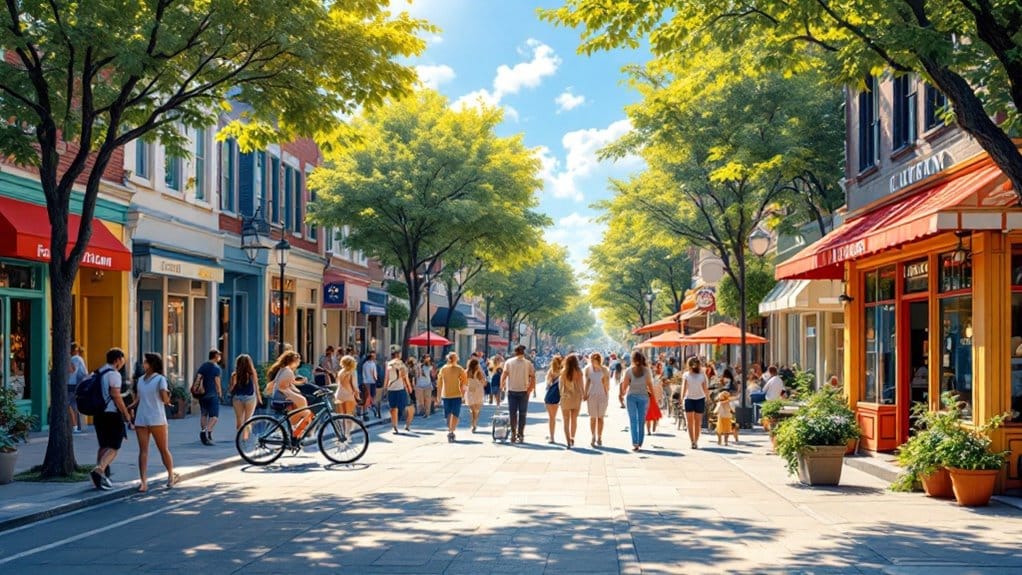If you're itching to explore on foot, check out these pedestrian-friendly cities! San Francisco dazzles with its iconic hills and public transit, while Jersey City offers vibrant streets and safe paths. Boston's historic charm leads you down the Freedom Trail, and Chicago's walkable neighborhoods keep the city buzzing. Minneapolis boasts incredible sidewalks everywhere you look, and Seattle's green spaces beckon you to stroll. Don't forget New York City, where bustling streets and cozy corners await around every turn. Each place has its flavor, promising you adventures around every block. Want to uncover more about these walking wonders?
Key Takeaways
- San Francisco ranks 3rd in the U.S. for walkability with a score of 89 and a focus on pedestrian infrastructure improvements.
- New York City, with a walkability score of 88, emphasizes safety initiatives like the Vision Zero Report for pedestrian protection.
- Boston, scoring 83, enhances walkability through public transport accessibility and historical sites along the Freedom Trail.
- Chicago promotes walkability with wide sidewalks, bike lanes, and safety measures under its Vision Zero program to eliminate traffic-related deaths.
- Minneapolis is recognized for its Gold-level community status for pedestrian safety and has over 80% of streets equipped with sidewalks on both sides.
San Francisco
San Francisco exemplifies the concept of walkability, boasting a ranking as the third most pedestrian-friendly city in the United States. With a walkability score of 89, you'll find traversing the city on foot a breeze. Imagine this: you're strolling through vibrant neighborhoods, parks, and iconic landmarks, all while knowing that pedestrian safety is a top priority here.
The city's Vision Zero Action Strategy is a game-changer, focusing on reducing pedestrian accidents and fatalities. You can feel the commitment when you see signalized intersections designed for everyone, using a maximum walking speed of 3.0 feet per second. It's not just about crossing the street; it's about creating an environment where you feel safe to explore.
San Francisco's walkability initiatives, like the Better Streets Plan and the Walk First Program, show a genuine investment in pedestrian infrastructure. Monthly Sunday Streets events close roads to cars, transforming streets into lively spaces for pedestrians and cyclists. You might even bump into a friend while enjoying the fresh air! Additionally, with a recorded pedestrian fatality rate of 2.35 per 100,000 residents, the city's commitment to safety is evident. So, whether you're grabbing coffee or heading to Golden Gate Park, the city's dedication to walkability makes every outing a delightful adventure.
Jersey City
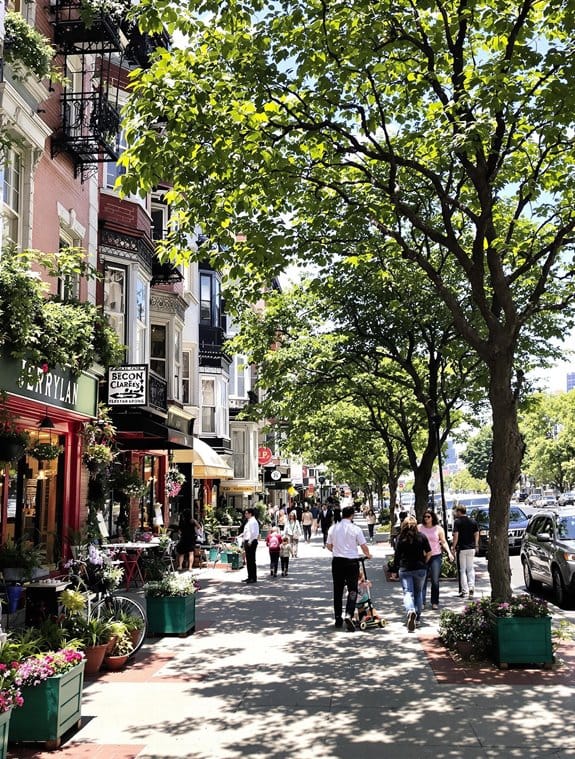
While San Francisco sets a high standard for walkability, Jersey City is making impressive strides of its own. You might not think of Jersey City as a pedestrian paradise, but let me tell you, the Jersey City initiatives are turning it into a vibrant space. With nearly 25 miles of protected bike lanes, you can safely zip around, and those pedestrian plazas? They're not just asphalt wastelands anymore; they're lively spots perfect for grabbing a coffee or chilling with friends.
The city's commitment to community engagement shines through its Tactical Urbanism. They've transformed streets, like Newark Avenue, into gorgeous walkable areas that invite exploration. Plus, the tree planting—over 1,000 trees—adds a rejuvenating green touch to the urban landscape, making strolls feel more like nature walks. Additionally, the historic downtown area, with buildings dating back to the 1880s and 1890s, adds a charming backdrop to your walks.
And here's something to celebrate: zero traffic fatalities in 2022! That's a big win for everyone. So, if you're considering a stroll or a bike ride, Jersey City welcomes you with open arms, making it one of the best places to live. Trust me; once you experience it, you won't want to leave!
Boston
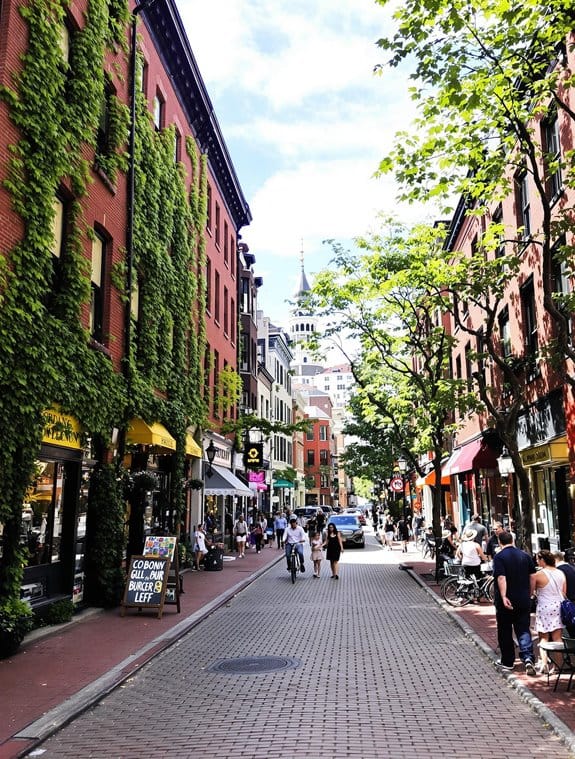
Boston is a city that thrives on foot, boasting an impressive walkability score of 83 out of 100. You'll quickly find that exploring its charming Boston neighborhoods is a real treat. Imagine strolling along the Freedom Trail, a 2.5-mile path that brings you face-to-face with 16 historical sites, each telling a piece of Boston history. It's like walking through a living museum!
As you wander through Beacon Hill, you'll notice its hilly streets lined with historic homes. With a walk score of 99, you can't help but feel the charm. And if you're in the mood for some delicious Italian food, the North End is just a few steps away, packed with cozy eateries and vibrant pedestrian areas. Additionally, you can take advantage of Boston's strong public transport options, which are perfect for reaching further destinations in the city.
Don't forget about Chinatown's Leather District, teeming with restaurants and shops that make it a lively spot to explore. Plus, Boston's public transportation is first-rate, with 115 bus routes and three subways ready to whisk you away. So lace up your shoes, immerse yourself in this pedestrian paradise, and let the city's rich history and lively neighborhoods unfold around you!
Chicago
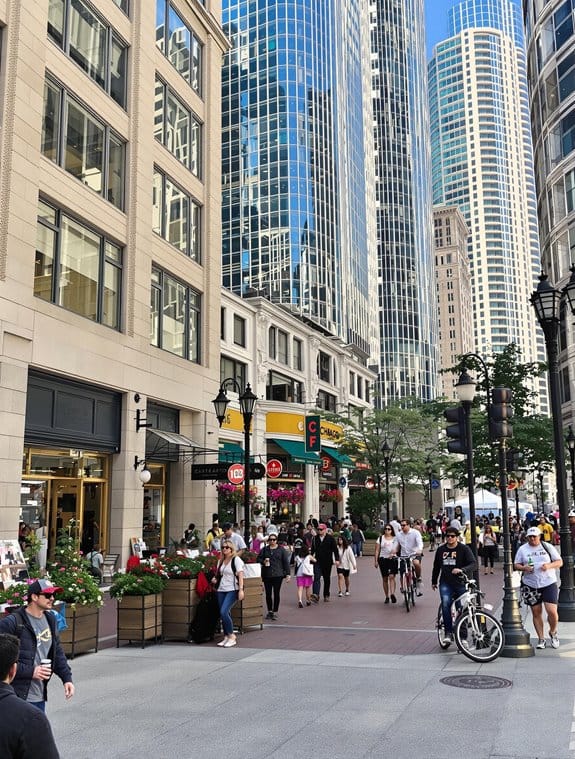
Chicago is another vibrant city that embraces walkability, offering a unique blend of urban life and pedestrian-friendly neighborhoods. Picture yourself wandering through Wicker Park, the most walkable neighborhood, where eclectic shops and mouthwatering eateries beckon you at every corner. Or head to East Ukrainian Village, with its lively atmosphere, local hotspots, and easy access to major bus routes.
You'll love the West Loop too, where wide sidewalks and dedicated bike lanes make strolling a breeze, surrounded by art galleries and trendy restaurants. Lincoln Park's inviting spaces and bustling commercial district are perfect for outdoor adventures, while Noble Square offers a mix of amenities and charming streets. Moreover, the commitment to improving walkability in Chicago is evident through various initiatives that enhance pedestrian safety and infrastructure.
Now, let's talk about Chicago walkability initiatives. The Vision Zero Chicago program aims to eliminate traffic-related deaths, while the 2012 Pedestrian Plan identifies ongoing efforts to boost pedestrian safety. With a pedestrian-first modal hierarchy, the city prioritizes your safety over cars. Plus, enhanced sidewalks and public transit make living without a vehicle a joy. Whether you're enjoying a leisurely stroll or grabbing a bite, Chicago's got your back, proving that walking in the Windy City is always a great idea!
Minneapolis
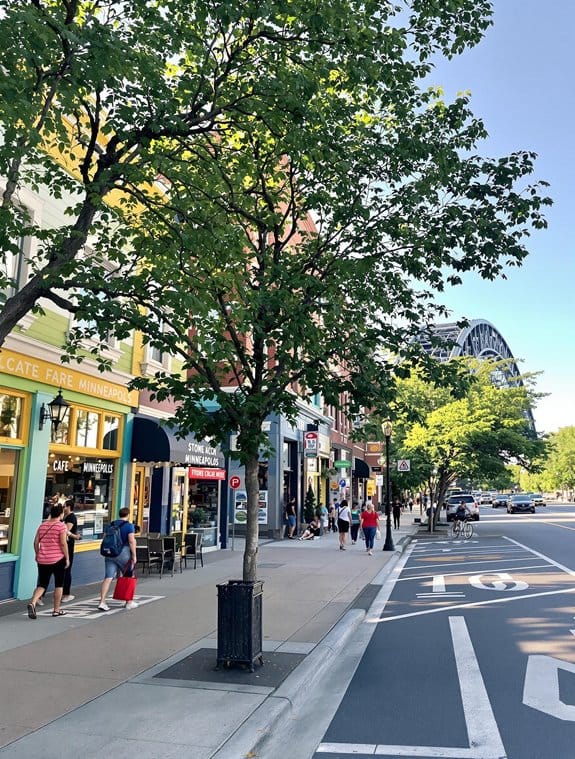
Embracing walkability, Minneapolis stands out as a Gold-level community dedicated to pedestrian safety and accessibility. You'll love the fact that over 80 percent of its streets boast sidewalks on both sides, making it a breeze to stroll around. With a solid Walk Score of 71, you can accomplish errands on foot without breaking a sweat.
Pedestrian safety is a top priority here. All marked midblock crosswalks come equipped with overhead flashing beacons and high-visibility striping. Plus, street lighting illuminates nearly all roads, so you'll feel safe even when the sun goes down. The city's Vision Zero Action Plan aims to eliminate traffic deaths by 2027, showing just how serious they are about your safety. Minneapolis's commitment to pedestrian safety is further evidenced by its extensive sidewalk network, ensuring safe passage for all residents.
Minneapolis also hosts fun pedestrian campaigns like Safe Routes and Open Streets MPLS, encouraging you to lace up those walking shoes. And don't worry about parking—maximum parking standards keep the area pedestrian-friendly. With a commitment to improving accessibility for everyone, including those with disabilities, you'll find a community that truly cares. So, if you're looking for a city that values your right to roam freely, Minneapolis is definitely the place to be!
Seattle
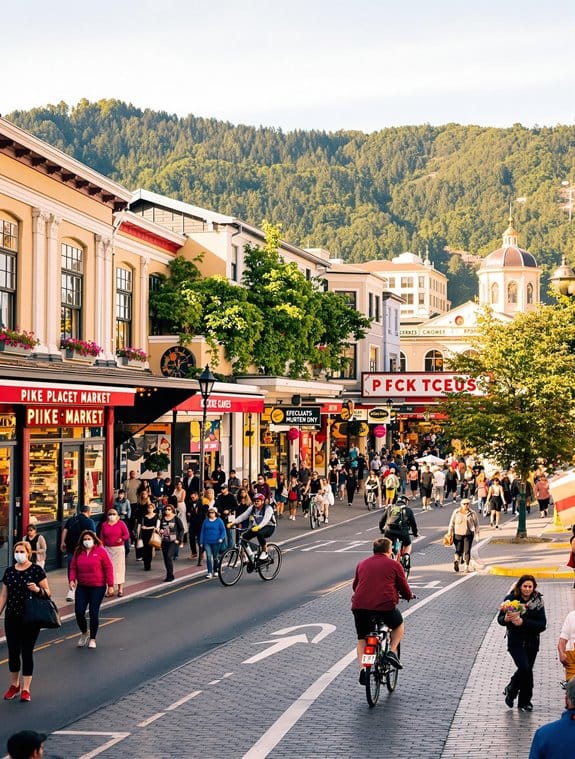
With its vibrant neighborhoods and stunning waterfront, Seattle is a city that invites you to explore on foot. You'll find that Seattle Walkability is pretty impressive, ranking as the 9th most walkable large city in the U.S. With a Walk Score of 74, most errands can be done without breaking a sweat. Picture yourself wandering through lively spots like Downtown or Capitol Hill, where shops and cafes are just a short stroll away.
However, it's not all sunshine and roses. While there are well-maintained sidewalks and crosswalks, only about 76% of streets have sidewalks, leaving gaps that can be tricky. Plus, those famous Seattle hills can add a bit of a workout to your stroll. And let's not forget about Pedestrian Safety—there's still work to be done to lower collision rates and improve the overall experience. In addition to these challenges, the city's commitment to public transit access enhances the overall walkability experience, allowing residents to easily navigate even the outlying neighborhoods.
But don't let that scare you off! Initiatives like the Vision Zero Report are tackling these issues head-on, aiming to make your walking adventures safer and more enjoyable. So lace up those shoes and get ready to explore this beautiful city, one step at a time!
New York City
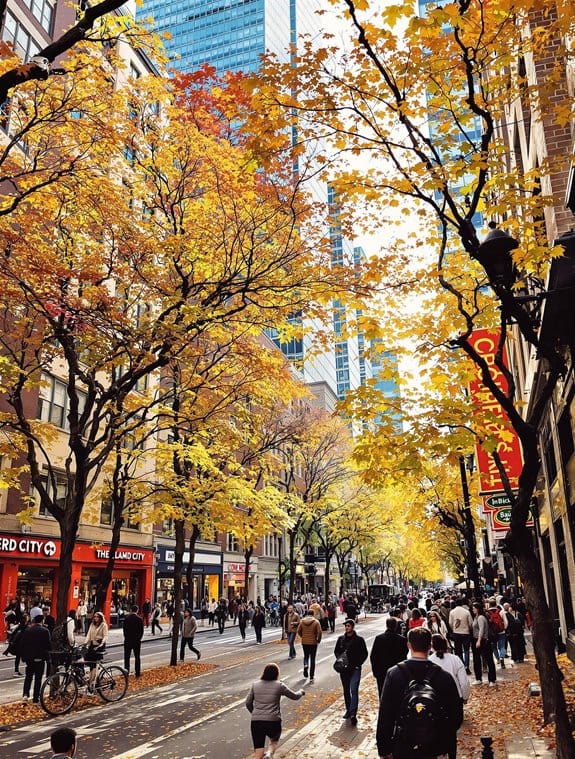
New York City stands out as a pedestrian haven, boasting a walkability score of 88 that places it second among U.S. cities. Picture strolling down Fifth Avenue, where exciting improvements are in the works. Between Bryant Park and Central Park, sidewalks will soon be widened by nearly 50%. This means more room for you and your friends to walk without bumping into each other! Plus, crosswalks are getting shorter, making it safer to dash across the street when the light turns green.
Did you know that 70% of traffic on Fifth Avenue is pedestrian? Yet, only 46% of the space is reserved for you to walk. That's why the city's pedestrian mobility plan is so essential. It's all about creating a safe, accessible, and comfortable experience. You'll find new trees and planters along the avenue, providing shade on those hot summer days and even helping with flooding. The redesign will also include stormwater infrastructure to prevent potential flooding issues.
With 37 proposed street safety projects, including bus and bike lanes, New York City is truly embracing a future where walking isn't just a way to get around but a joy. So grab your walking shoes—this city is ready to welcome you!
Frequently Asked Questions
How Do Walkable Cities Impact Local Economies?
While sprawling suburbs drain resources, walkable cities foster economic growth through smart urban design. They attract businesses, enhance property values, and create vibrant communities, making them essential for sustainable development and improved quality of life.
What Are the Health Benefits of Walkability?
Walkability offers significant health benefits, like improved mental health through increased social interaction and physical activity. Plus, it contributes to environmental benefits, reducing pollution and promoting a healthier lifestyle, enhancing your overall well-being.
How Can I Advocate for More Pedestrian-Friendly Initiatives?
You can advocate for pedestrian-friendly initiatives by raising public awareness through workshops and social media. Engage in urban planning discussions, collaborate with local businesses, and push for funding that supports effective, accessible pedestrian infrastructure improvements.
Are There Specific Laws Supporting Pedestrian Safety?
Yes, there're specific laws supporting pedestrian safety. You'll find zoning regulations that promote walkable communities and traffic calming measures designed to reduce vehicle speeds, making streets safer for pedestrians and encouraging more foot traffic.
What Role Do Community Groups Play in Promoting Walkability?
You'll find community groups essential in promoting walkability through community engagement and urban design. They mobilize local support, secure funding, and advocate for safer infrastructure, ensuring everyone can enjoy accessible, walkable neighborhoods.

